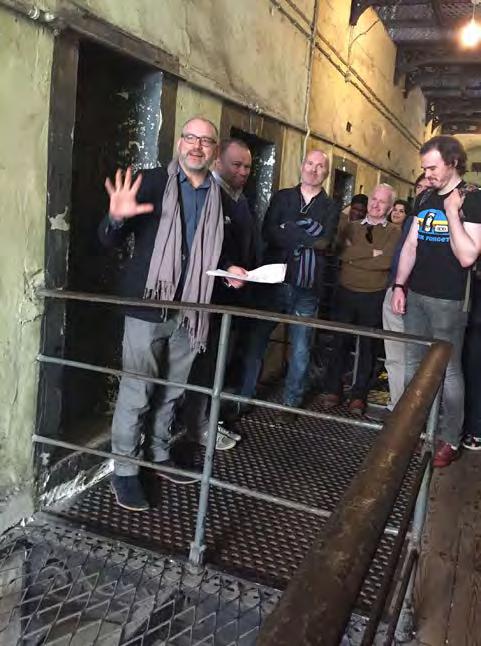
16 minute read
Including LGBTQIA+ history in the Cultural Sector
from Museum Ireland, Vol. 27. Widdis, B. (Ed.). Irish Museums Association, Dublin (2021)
by irishmuseums
MUSEUM IRELAND 2020
Including LGBTQIA+ history in the Cultural Sector
Advertisement
Kate Drinane, Judith Finlay & Brian Crowley
Introduction
Since 2017, Kate Drinane from the National Gallery of Ireland, Judith Finlay from the National Museum of Ireland, and Brian Crowley from Kilmainham Gaol have worked on LGBTQIA+ research and events within their respective institutions. At the Irish Museums Association’s 2020 annual conference in Athlone, they delivered a workshop to share their experience and knowledge with others who may wish to address the subject. In March of 2021, all three institutions successfully collaborated to run OUTing the Past Dublin 2021: The Festival of LGBT History virtually. This article records a conversation explaining their motivation and processes for this work.
Why: Why did we get involved?
Kate Drinane: In early 2018, the Irish National Teachers Organisation LGBT teachers’ group asked me to research an LGBT-themed tour of the Gallery. I was happy for the opportunity to research a topic in the Gallery’s collection that I had always been interested in and wanted to highlight to the public. I wanted to use this as a starting point for long-term, well-rounded programming that would allow LGBTQIA+ stories to be told in various forms in the Gallery.
Judith Finlay: In 2017, I started my PhD research with Trinity College Dublin focusing on ‘The Healing Museum’ and the use of right-based structures to transform museum practice. I received approval from the Head of Collections and Learning to identify the most effective way to bring LGBTQIA+ history into the National Museum of Ireland, the NMI, initially via the Archive. The existing NMI collections tell a significant amount of LGBTQIA+ histories.
Brian Crowley: While there has always been a general awareness in Kilmainham Gaol Museum that the building had been used as a place of punishment for men who engaged in homosexual acts in the nineteenth and early twentieth centuries, it was not until the publication of Brian Lacey’s seminal Terrible Queer Creatures: Homosexuality in Irish History that we discovered its central role in the 1884 Dublin Castle Scandals. Although largely forgotten for over a century, this was one of the biggest political stories of the 1880s and involved a number of men, including some senior figures in the British administration, who were prosecuted for homosexual activity. Among other things, the story highlighted how, at a time when society largely refused to recognise the existence of homosexuality, prisons were often one of the few places in which queer lives were visible. In order to punish those who engaged in homosexual activity, the authorities first had to name and acknowledge that those acts had taken place. Kilmainham Gaol is thus one of the few historic spaces in which LGBTQIA+ stories were visible and overt, therefore it felt incumbent on us as a Museum to explore and share this aspect of the building’s history.
Brian Crowley leading the Kilmainham Gaol LGBT+ Tour, 2019.
Credit: Kilmainham Gaol, Office of Public Works
Kilmainham Gaol is, of course, much more than just a prison and has become in many ways a secular shrine dedicated to those involved in the fight for Irish independence across two centuries. Lacey’s book also recounts a number of queer people who played a leading role in that struggle even if, previously, being LGBTQIA+ was often portrayed as being somehow incompatible with being truly Irish. Elements within Irish society often went to great lengths to deny the queer identity of historical figures involved in the independence struggle. In the face of this deliberate silencing, it became very apparent to us that Kilmainham Gaol had a key role in acknowledging and promoting the role of LGBTQIA+ people in the foundation of the Irish state.
What: What did we do?
Kate: After the tour for the teacher’s group at the beginning of 2018, I carried on my research and rolled out several public tours for Dublin Pride 2018. On each tour I asked the participants for any hints or research links they knew of, as finding LGBTQIA+ stories in history can be difficult. This community-based research methodology worked brilliantly and means that the research is still continuing today. The tours were then embedded in the monthly Public Tour programme. This was to emphasise that LGBTQIA+ history exists year round and not just at Pride.
In 2019, the Gallery hosted the LGBT History Festival, OUTing the Past. It was the first time there had been a festival hub in Dublin. This festival included a full day of talks, breakout discussion sessions and a choir performance from Gloria, Dublin’s Lesbian and Gay Choir. Sara R Philips delivered the opening address and the closing remarks were from Panti Bliss.
With the growing success of the LGBTQIA+ programming in the Gallery, I planned a series of talks and tours for Dublin Pride 2019. The Gallery staff also marched in the Dublin Pride parade with the Civil Service LGBT+ Network. As a growing number of LGBTQIA+ people started to visit the Gallery, it was important to train up the Gallery’s front-facing staff and volunteers in best practice when welcoming the community into the Gallery. I ran four LGBTQIA+ Awareness sessions focusing on language and acceptance of the community. These were very successful from an educational perspective. However, they did involve an unexpected amount of emotional labour. This is something I would recommend outsourcing, as a level of separation from participants is helpful.
Even in a world of lockdowns and COVID-19, the Gallery has continued to engage with the LGBTQIA+ community. Since February 2020, I have been working with Gaisce LikeMinded, a group founded by Gaisce to offer one-to-one mentorship for young LGBTQIA+ young people and their allies who are undertaking the Gaisce Awards. Originally planned to be a series of onsite workshops, COVID-19 meant that the workshops had to move online and have continued there. The group is working on art in various media that express what it feels like to be a young LGBTQIA+ person in the world today. These artworks will go on display to the public at the end of July 2021.
Across the Gallery’s social media and website, we have continued to offer LGBTQIA+ history to the public, in the form of Instagram stories and online self-guided tours. The LGBTQIA+ Through a Lens self-guided tour on the Gallery’s website is a way to look more closely at specific LGBTQIA+ stories in the Gallery’s collection.
Judith: In 2017 I started discussions with Tonie Walsh, Curator of the Irish Queer Archive (IQA) on ways to bring LGBTQIA+ history into the NMI. Initially we analysed private, community and public archives and collections already available, following which the aim was to identify the most effective ways to complement existing archives and collections and address gaps in the public record.
Working with NMI Archivist Emer Ní Cheallaigh in 2018, we approached the Department of Justice, Equality and Law Reform to add several actions to increase LGBTQIA+ representation at the NMI into the National LGBTI+ Inclusion Strategy.
Dr Panti Bliss giving the closing speech at the National Gallery of Ireland for OUTing the Past, 2019.
Credit: Jack Caffrey, The Pimlico Project, 2019 We used existing resources from the IQA in the National Library of Ireland (NLI), the Irish Trans Archive (ITA), Cork LGBT Archive, the LGBT Oral History project of Edmund Lynch and many more sources to create a nationally-focused digital introduction. Key members of the community co-curated this, primarily Tonie Walsh, Sara R Phillips, Edmund Lynch, Dr Patrick McDonagh and Orla Egan.
In February 2019 our Commercial Development Manager, Terri McInerney successfully secured Collins Barracks as the location for the Dublin LGBT Pride Mother Block Party. To reflect this LGBTQIA+ event within the museum, Rainbow Revolution was launched on 27th June 2019. This consisted of:
• A digital introduction to Irish LGBTQIA+ history. • A rainbow trail highlighting LGBTQIA+ associations. • A ‘Pop-up’ exhibition of the four objects. • New interviews to launch the LGBTQIA+ Living
Archive Project.
The digital resource was available on four touchscreens in Collins Barracks, and one in Turlough Park, Mayo, providing an accessible
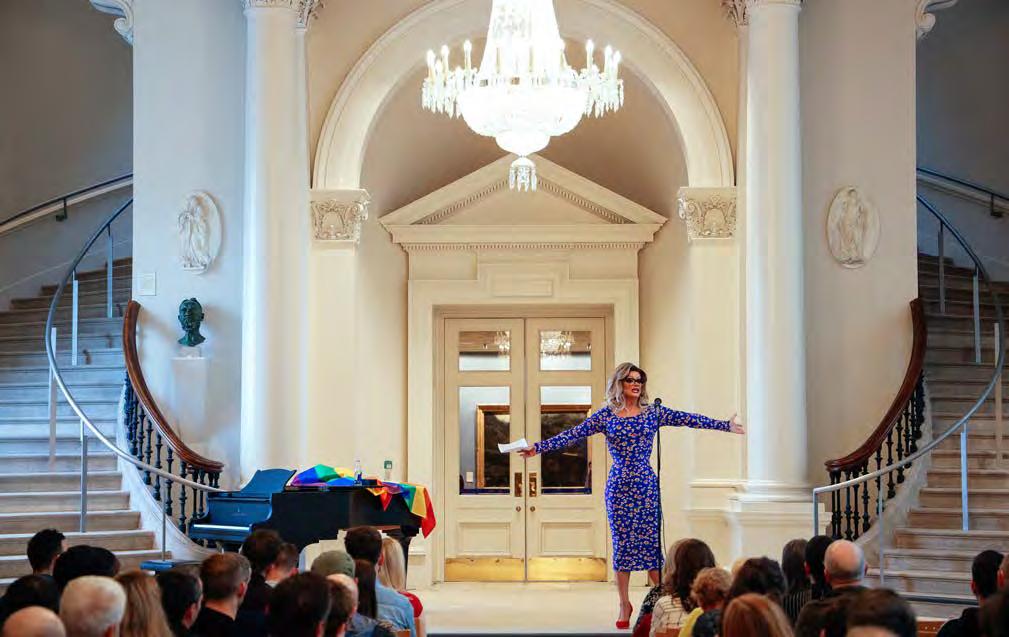
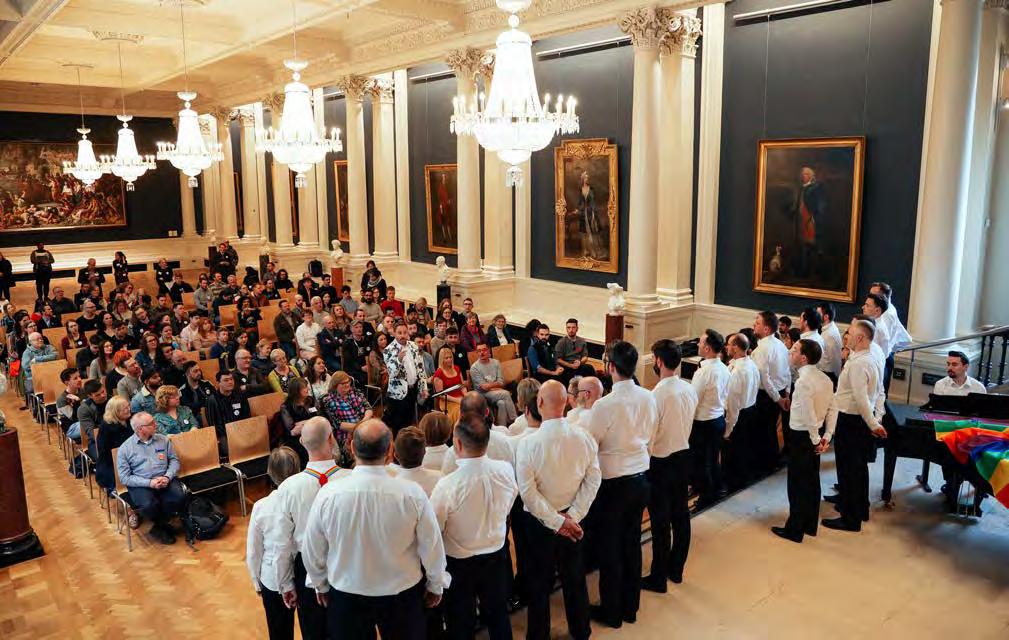
Gloria, Dublin Lesbian and Gay Choir, the final performance at the National Gallery of Ireland for OUTing the Past, 2019.
Credit: Jack Caffrey, The Pimlico Project, 2019 her wife, Ann Louise Gilligan. Soon after, Panti Bliss donated the dress she had worn when giving the Noble Call Speech in the Abbey Theatre.
introduction to the Irish LGBTQIA+ movement. It introduced the Irish LGBTQIA+ rights movement and highlighted existing resources people could use to explore this history further. The introduction also launched the current NMI LGBTQIA+ Living History Project with two new interviews: one with Mary Shannon, custodian of the AIDS Memorial Quilts and another with Senator David Norris.
Alongside this was a display of the first four LGBTQIA+-associated objects acquired by the NMI, with Shane Harte’s The Wall of Oppression art installation as its backdrop. Brenda Malone, an NMI Curator, began to collect material relating to Ireland’s 2018 Abortion Referendum and the LGBTQIA+ collection grew from there. Conor Kelly donated a Pride flag used to cover graphic Pro-Life posters during the campaign. In 2019, Katherine Zappone donated her wedding dress and that of These objects featured on the Rainbow Trail – a self-guided trail for visitors, leading them through the current exhibitions and highlighting objects with LGBTQIA+ connections. This trail brought together staff knowledge of the collections from across the NMI, and was coordinated mainly by Declan Walsh with our Education, Registration and Curatorial colleagues. These objects are now on display in Exhibiting the Nation. ‘Under the Rainbow’ provided LGBTQIA+ Awareness Training for staff.,
Brian: The opportunity to focus on the LGBTQIA+ history of the Gaol arose with the Dublin Festival of History in 2018. We were anxious to take part in the festival and offer something different and new and, as such, we submitted a proposal to give a queer history tour of the building. We chose to do a tour rather than a lecture because we wanted to emphasise that these stories were part of the history of the building itself. The tour proved incredibly popular and was quickly oversubscribed. We scheduled a number of additional tours in the weeks to facilitate those on the waiting list, and
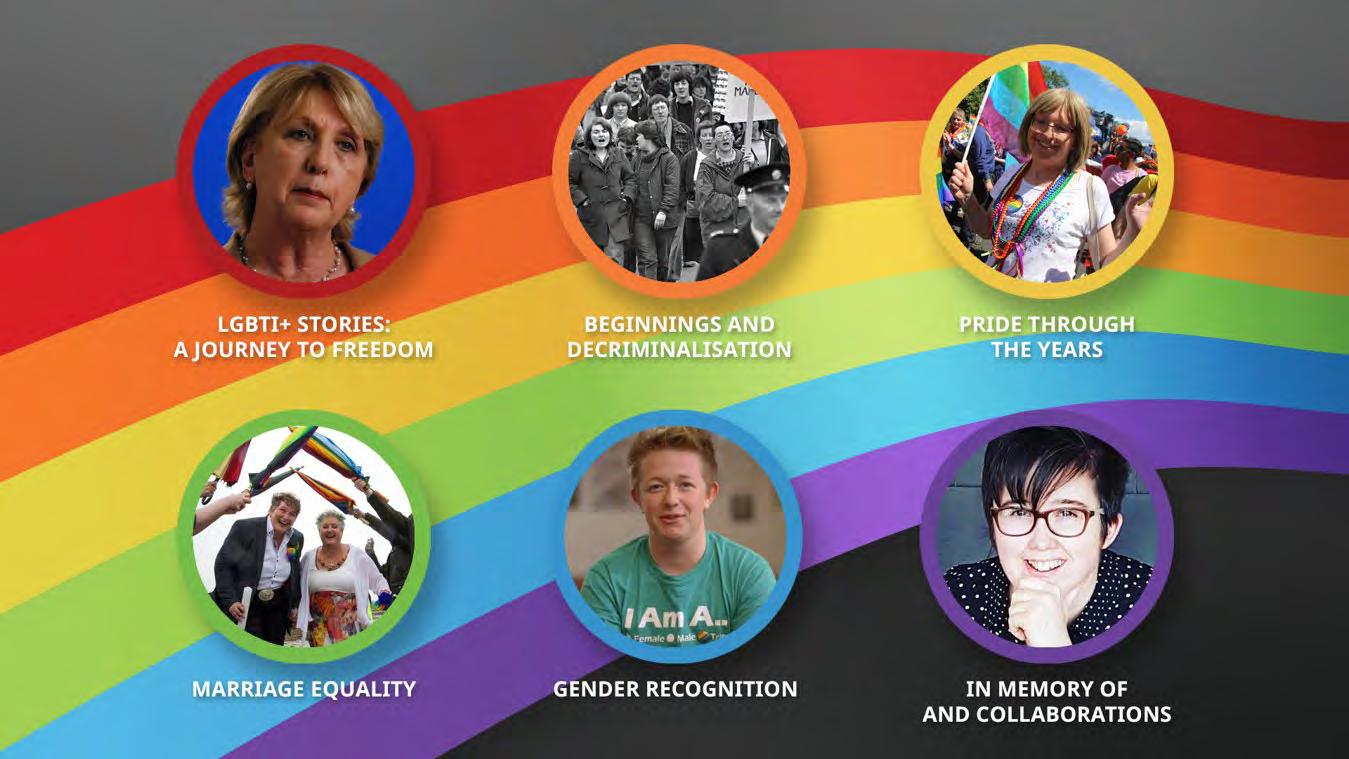
Above: The Rainbow Revolution touchscreen introducing Irish LGBTI+ history at the National Museum of Ireland, 2019
Credit: National Museum of Ireland. Below: The Rainbow Revolution loop screen at the National Museum of Ireland, 2019
Credit: National Museum of Ireland.
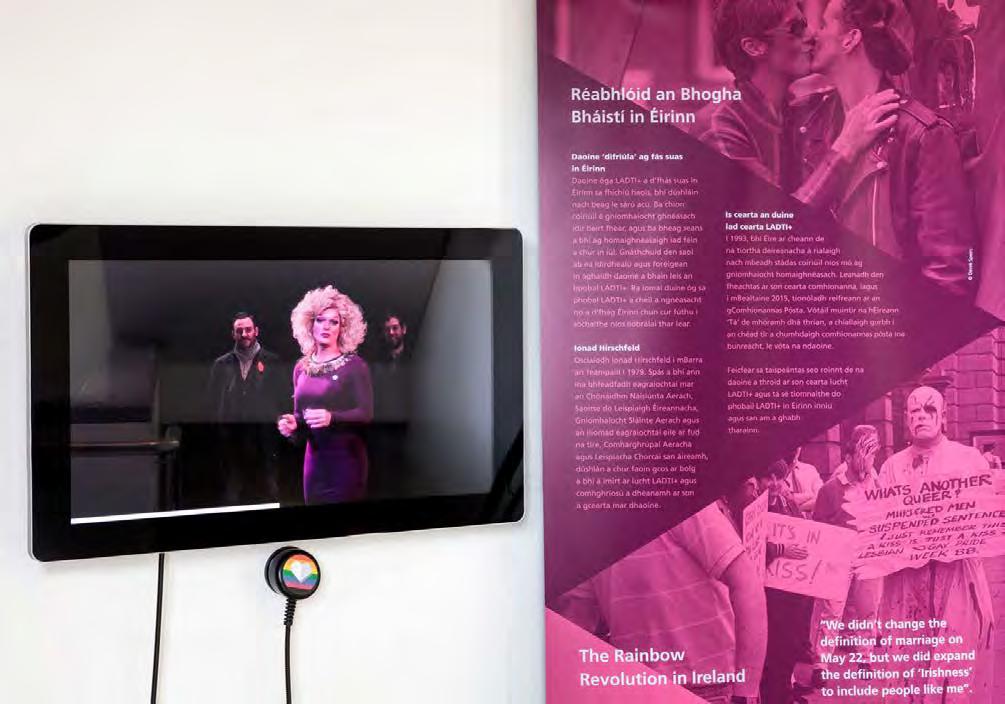
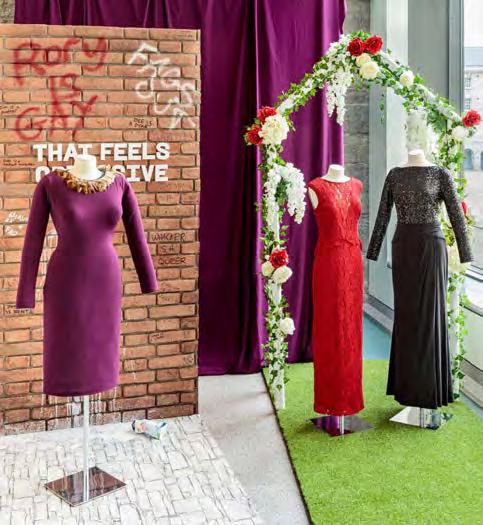
The Rainbow Revolution ‘Pop Up’ exhibition at the National Museum of Ireland, 2019.
Credit: National Museum of Ireland
further tours also took place as part of the Dublin Pride Festival in June 2019.
Using the research we had carried out into the Gaol’s LGBTQIA+ history, we explored the museum’s collection for objects related to these stories. This resulted in a small exhibition, also for Dublin Pride, of LGBTQIA+ material from the Kilmainham Gaol collection. The ‘queering’ of the collection has become an ongoing project and we continue to identify and highlight objects which may have LGBTQIA+ associations. We are also actively seeking to increase the representation of queer material within the collection.
How? How do you programme LGBTQIA+ events?
Kate: Begin by learning the terminology. There are excellent resources out there for learning about the LGBTQIA+ acronym, how to use people’s correct pronouns and make them feel as safe as possible in a new space. Once I began the research into LGBTQIA+ stories and lives in the Gallery collection, I quickly discovered that a huge amount of the stories were hidden and often hard to find among all the heteronormative narratives. What I came to rely on most was hints and tips from my colleagues and from visitors on tours. This was a simple and clear way to engage with Judith: The key to this was building strong relationships with the community, empowering them and giving them the freedom to tell their history. Everyone I approached was extremely generous with their time and knowledge, willing to co-curate with us and build the permanent public historic record. Give the LGBTQIA+ community a voice in your work to ensure it is a true and accurate reflection.
Brian: Ironically, while the content of our LGBTQIA+ was new and challenging, the way we delivered it relied on existing formats such as tours and exhibitions. That did not mean that creating a programme of LGBTQIA+ events was without its challenges. Queer history is often, and necessarily, speculative. Museums, on the other hand, have traditionally traded in certainties and have presented themselves as the ultimate authority in their given subject area. When it comes to queer histories we are often unable to offer definitive answers, but we can offer thought-provoking questions instead.
When? When is a good time for LGBTQIA+ programming and engagement?
Kate: While it can be simpler to programme events during Pride, I have found that there is a keen appetite for LGBTQIA+ events and content all year round. Even during a visit from the Pope in August 2018, we had 26 people attend that Saturday’s LGBTQIA+ tour. Pride can be a good starting-point to drum up enthusiasm from the public and to raise awareness, but relying on it can be reductive and come across as tokenistic. You can use events like Winter Pride to reinvigorate your programme and make new connections within the community.
Judith: Pride is a good time to start if your cultural space has never dealt with LGBTQIA+ history and culture before. There are regional Pride marches across the country all through the summer (when Covid-19 calms) as well as Winter Pride. As with the histories of any marginalised groups – women, Travellers, people of colour, it is important we embed LGBTQIA+ history within all of our Irish history narratives, to show genuine inclusion
Brian: Programming events for the Dublin Pride Festival and flying the rainbow flag for that week was a really significant way to demonstrate to the LGBTQIA+ community that the Museum was fully embracing their history. It was also a way of reaching new audiences who may not have been aware of Kilmainham’s significance in Irish queer history. It should be noted that LGBTQIA+ events do not always have to be tied to things like Pride festivals. Culture Night, Heritage Week and other history festivals could be useful opportunities to focus on LGBTQIA+ stories and they should also form part of a museum’s regular exhibition and education programming.
Who? Who is involved in the planning?
Kate: The LGBTQIA+ programming in the Gallery
Kate Drinane at the National Gallery of Ireland for OUTing The Past, 2019.
Credit: Jack Caffrey, The Pimlico Project, 2019 started very slowly. This allowed time to involve as many members of staff as possible. All levels within the Gallery structure had to accept the programming, from the volunteers and tour guide panel all the way up to the Director. This meant that the LGBTQIA+ community would feel welcomed and supported at all times. All of the Gallery staff were extremely helpful.
Judith: Our community curators and content providers were central to all of this. They had ownership from the start and drove its success. This became very apparent at the NMI symposium ‘Out On Display’ in October 2019. This event sparked a series of collaborations including ‘The Everywoman Project’ created in 2020 by the Stairlings Collective for the Herstory Ireland Project.
Brian: It is vital that initiatives around LGBTQIA+ inclusion are not seen as purely the preserve of education and outreach departments. Curatorial, exhibition and documentation staff have a vital role in developing our understanding of queer history in museum collections. Without research to underpin them, the initiatives we have embarked upon in terms of promoting an understanding of Kilmainham Gaol’s queer history would have been impossible.
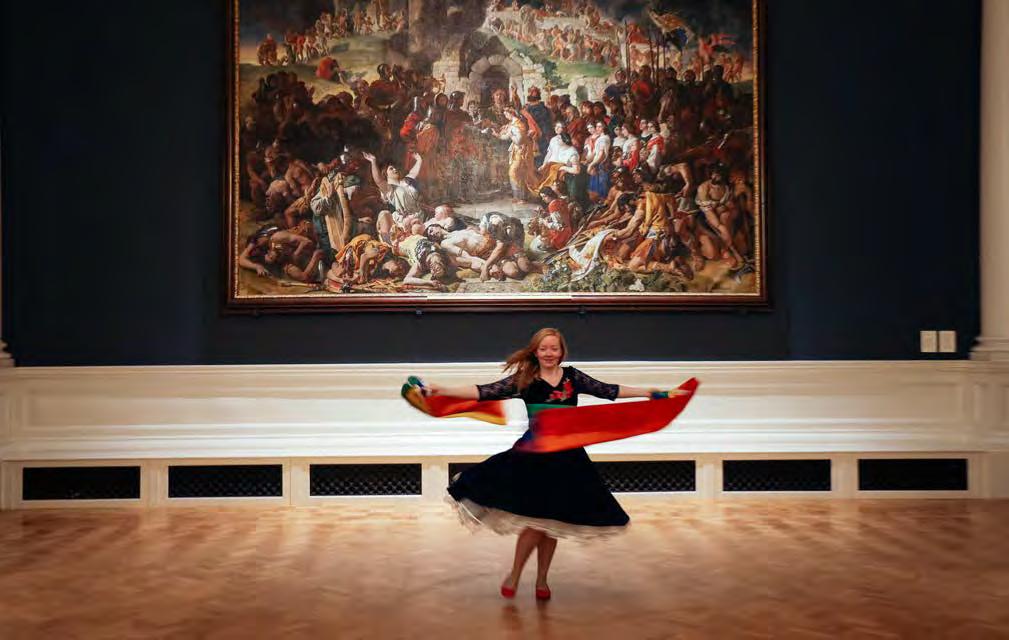
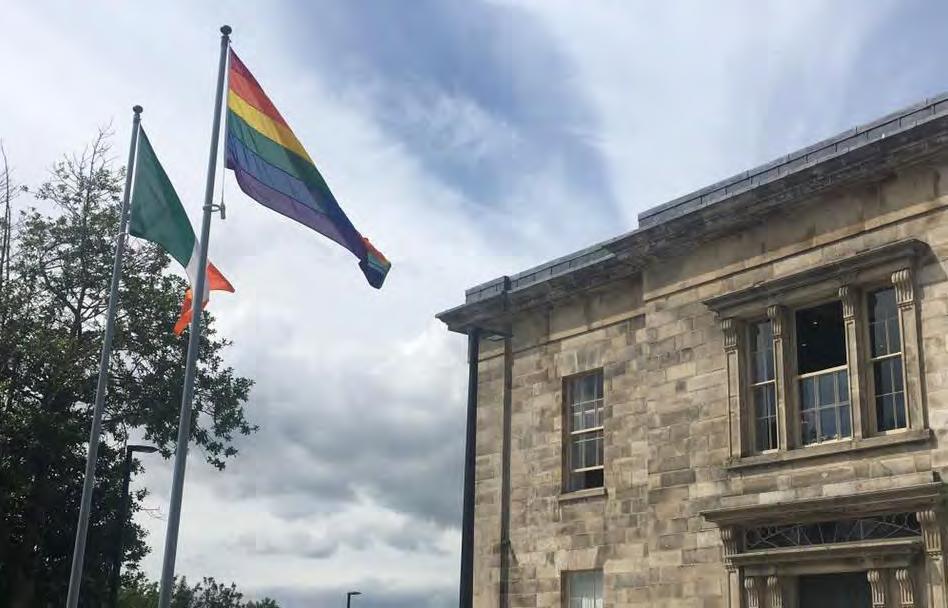
The Rainbow Flag over Kilmainham Gaol, 2019.
Credit: Brian Crowley
Who: Who is the event or content for?
Kate: While most of the LGBTQIA+ events and research were aimed at people in the LGBTQIA+ community themselves, we wanted the content to be accessible to all. We assumed no prior knowledge of the community or specific terminology associated with it. The Gallery uses the inclusive LGBTQIA+ acronym, however we wanted to ensure that as many as possible of the identities included in that are represented in our research and content. This can be difficult in a predominantly historical collection, and will need a continuous extra effort from staff.
Judith: Bringing this history into the NMI introduced it to audiences who may never have encountered LGBTQIA+ history before, increasing awareness and visibility. For LGBTQIA+ people, having their history alongside other aspects of Irish history can show them they are welcome and equal and that their history deserves to be preserved and available to everyone. Brian: We found that there was a significant appetite for queer history-related programming, and that the audiences for these events did not just come from the LGBTQIA+ community. These are fascinating stories and we found that a broad range of people, many of whom were not LGBTQIA+ themselves, were eager to engage with what was previously a little-known aspect of the building’s history. Many visitors were particularly interested in how the use of the Gaol, as a place of punishment for homosexual men in the nineteenth and twentieth centuries, was representative of the way in which the penal and judicial system was used to control and repress all kinds of groups within Irish society who were deemed to be transgressive.
If you would like further assistance
Please do contact the relevant institution if you wish to know more about this work.
In 2019, we founded Queer Culture Ireland, a research support network for anyone interested in, working on or researching LGBTQIA+ culture aimed at raising visibility, queering collections and catalogues, and consisting of a large number of experts all willing and able
to help with any LGBTQIA+ Culture projects or work you wish to undertake. Feel free to contact us queercultureireland@gmail.com or through Twitter @QueerCultureIre Instagram @ QueerCultureIre









